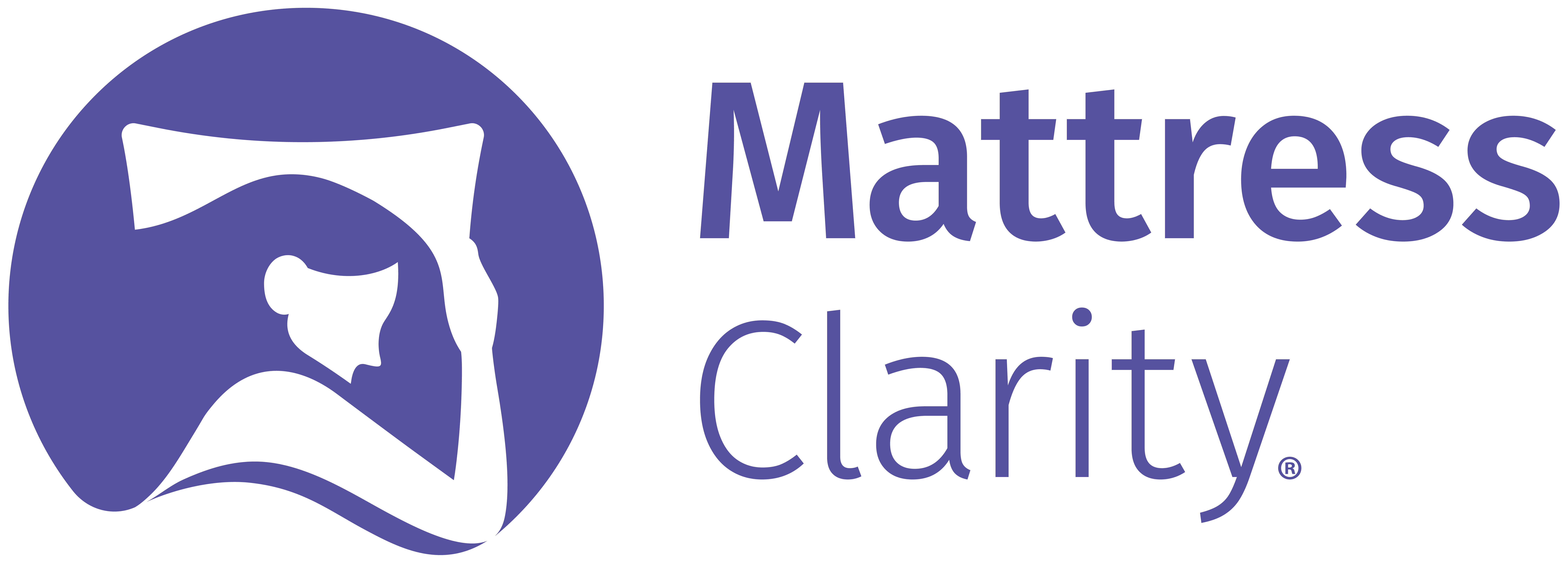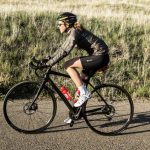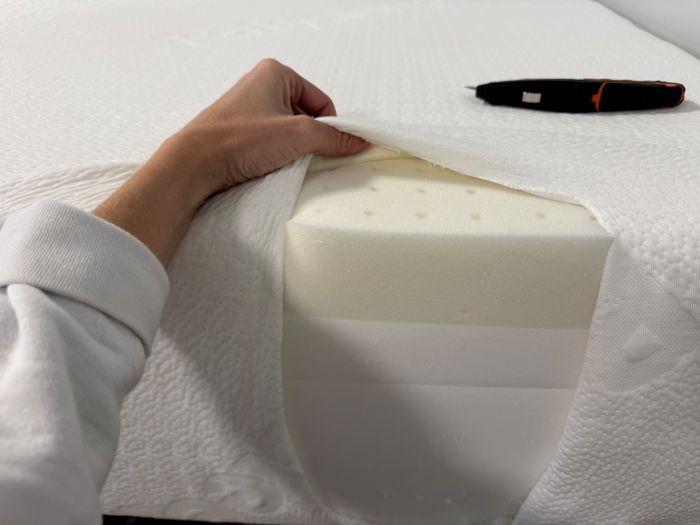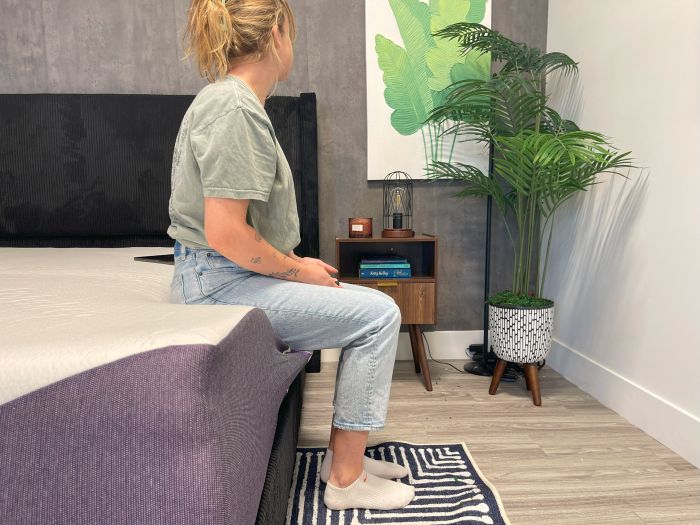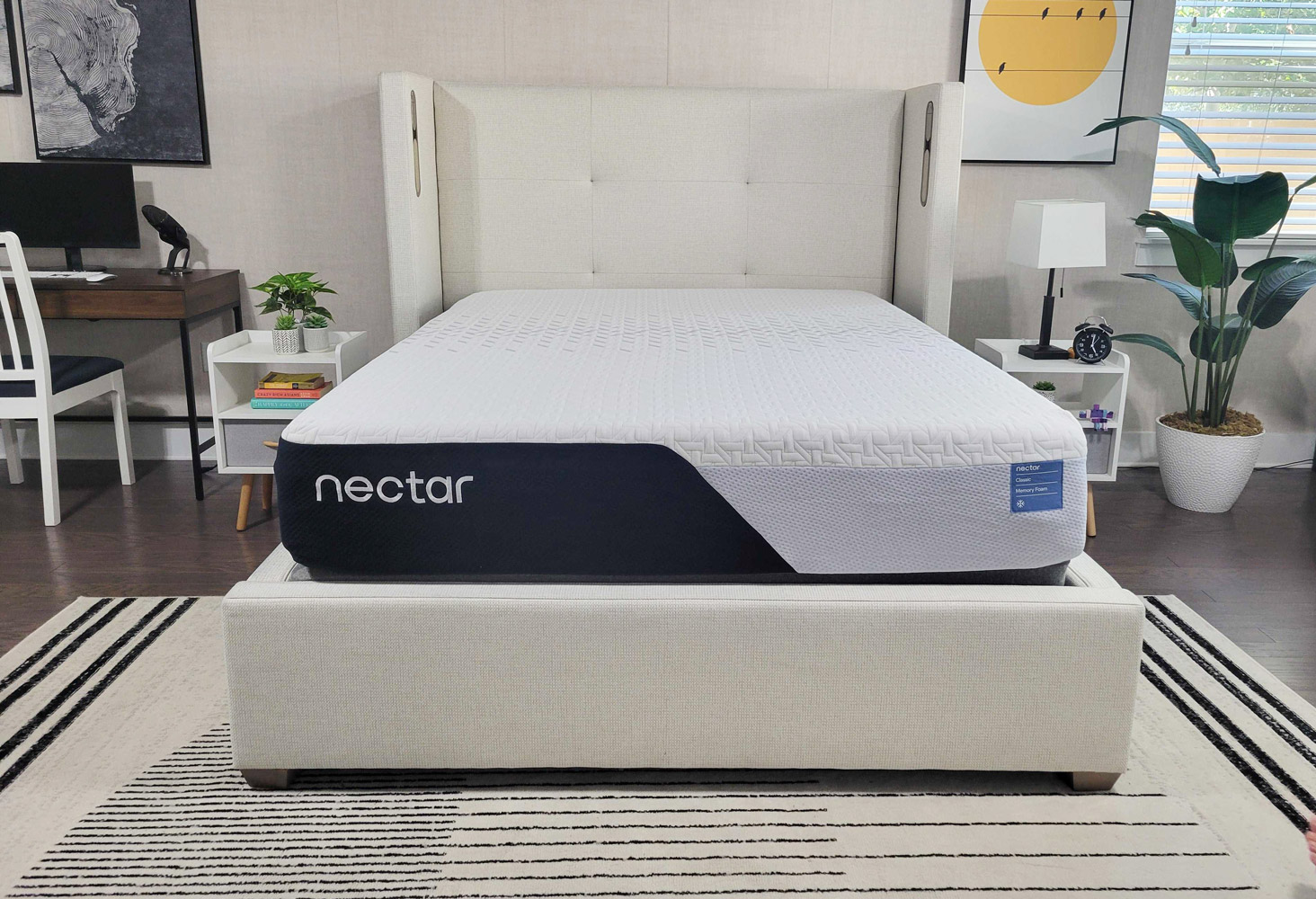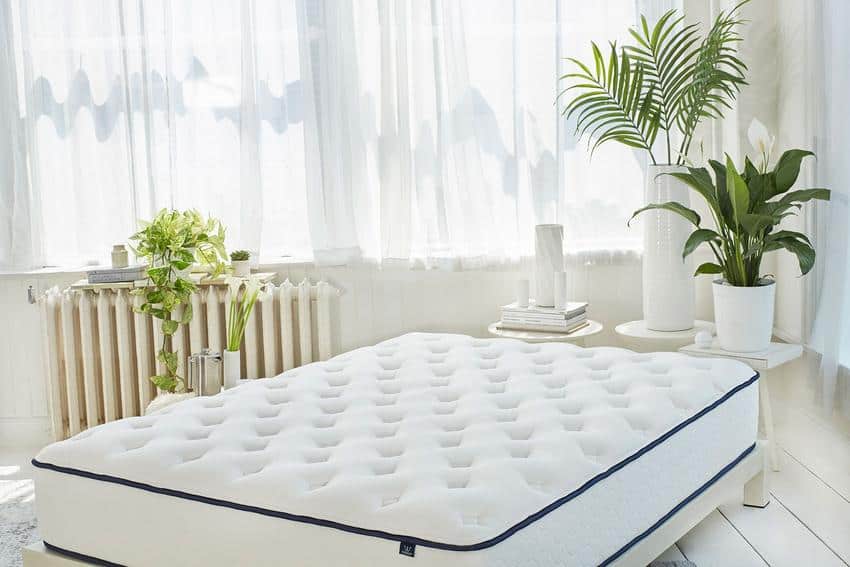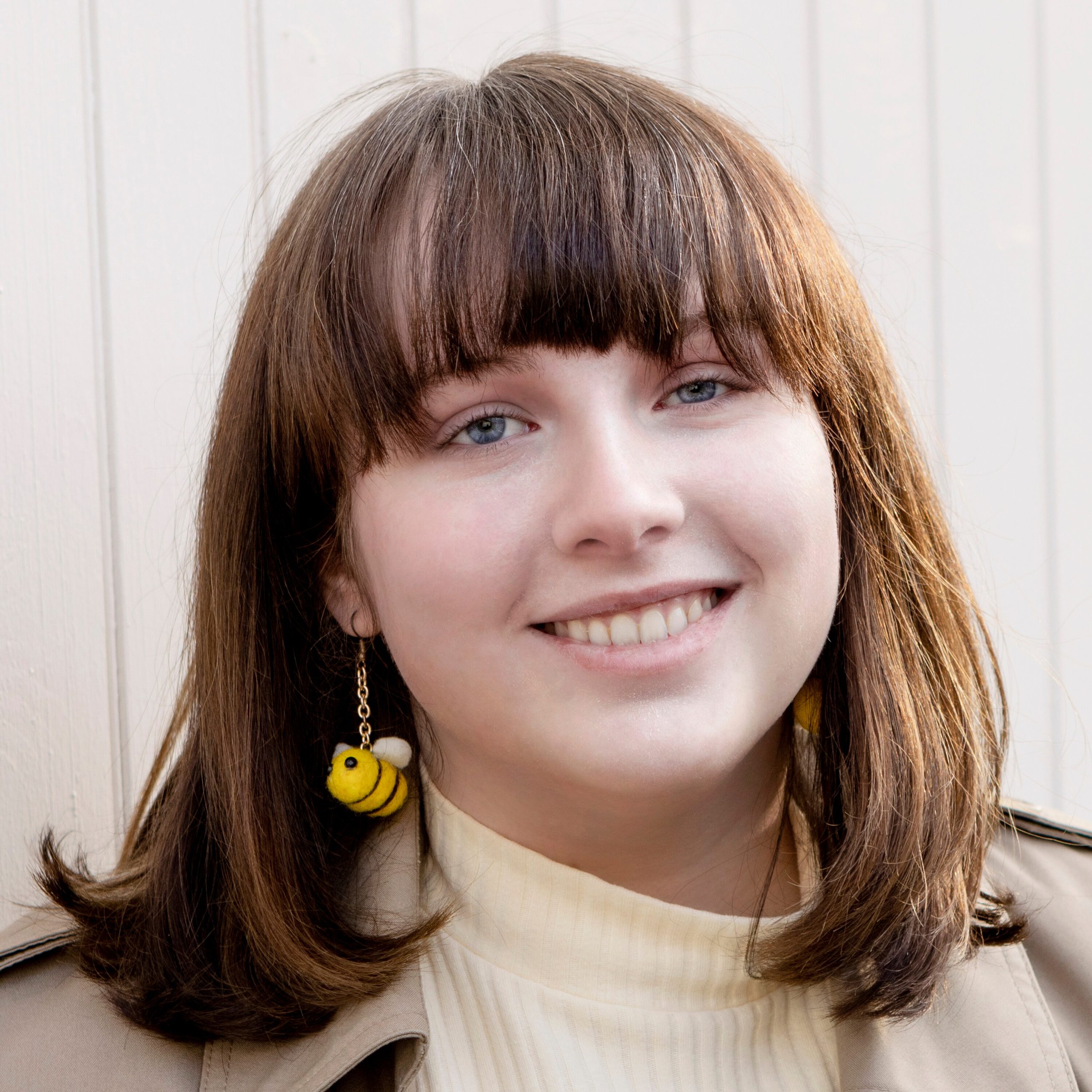Polysleep is a Canadian mattress company that makes high-quality beds, thoughtfully constructed in Montreal. If you’re a foam mattress fan looking to shop locally (or support your neighbors to the north), you’re in luck: Polysleep has three to choose from. The Polysleep Luna mattress is the brand’s newest offering (as well as its tallest and most expensive). We took it for a spin to see if it lives up to the hype.
Mattress Clarity has been testing mattresses for more than seven years—over 500 different models to be more precise, and a number of them Canadian-made. Our testers are certified sleep experts, backed by experience and input from medical experts like our chief advisor, Dr. Raj Dasgupta. The proof is in the pudding; we’ve helped 35,000 customers find their new favorite bed (5,919 of those in 2024).
Think you’re next? Read this review to see whether the Polysleep Luna will have you feeling over-the-moon.
Polysleep’s Luna model is the brand’s most expensive, lofty foam mattress. It won’t have you sinking in like traditional memory foam, but it will provide necessary support for back sleepers wanting a lifted feel. It performed well in our motion isolation and response tests, meaning it should work great for sexually active couples. Unfortunately, it’s not the coolest mattress, and the edges are lacking support, so keep that in mind before purchasing.
Polysleep Luna Mattress Performance: My Overall Rating
We designed our testing methodology to capture how a mattress looks, feels, and performs. This is so we can get a holistic view of who each mattress will work best for—and help guide our readers to their next favorite bed. After all our evaluations are complete, we rate each category out of 5, and then average them all into a final overall rating for the entire mattress, also out of 5.
When it comes to the Polysleep Luna, this mattress had some areas it performed well in and others in which it missed the mark. It earned its highest scores in motion isolation (4.7/5) and response (4.5/5), with its lowest score being in cooling (2.5). This resulted in an overall rating of 4.0 out of 5.
To find out more about each individual metric, hover over the bubbles for a quick description. Or read on for an in-depth evaluation of each testing category.
I Recommend the Polysleep Luna For…
- Combination sleepers – Despite the Luna being an all-foam mattress, our testers found it was easy to switch positions on the surface.
- Couples – You should be able to sleep soundly next to a restless partner with the bed’s low motion transfer.
- Back sleepers – This bed’s lifted, medium-firm feel is best-suited for back sleepers.

I Don’t Recommend the Polysleep Luna For…
- Hot sleepers – Foam mattresses aren’t known for running cool, and that’s the case with the Polysleep Luna.
- Stomach sleepers – This mattress may still be too soft to properly support stomach sleepers and keep their hips from sinking out of alignment.
- Side sleepers under 130 pounds – Lightweight side sleepers likely won’t sink comfortably into the mattress and get much pressure relief.
How Firm Is the Polysleep Luna Mattress?

At Mattress Clarity, our firmness scale goes from 1 to 10, with 1 being the softest and 10 being the firmest. Most mattresses fall around the 6.5/10 mark, which we (and many mattress manufacturers) call medium-firm. The Polysleep Luna mattress falls just a half-point higher on the scale at 7/10. We’d still call this medium-firm, but with a slightly firmer feel.
Despite the fact that the Polysleep Luna is an all-foam mattress, this firmness means you probably won’t get the deep sinkage you might expect from a more traditional, softer memory foam mattress. You’re likely to feel more “on top” of this mattress, so if you like lift, this might be the bed for you.
How Well Did the Polysleep Luna Perform?
As mentioned, we put these beds through the wringer, and we’ve done it hundreds of times, so we have an idea of what makes a good bed. We also have an idea of what the average mattress looks like. Here’s how the Polysleep Luna scored when compared to the average of all the beds we’ve tested over the years.
| Test | Performance | Average |
| Firmness | 7/10 – Medium-Firm | 6.7/10 – Medium-Firm |
| Side Sleeper Comfort | Good | Good |
| Back Sleeper Comfort | Good | Good |
| Stomach Sleeper Comfort | Unpleasant | Good |
| Pressure Relief | 3.3/5 | 3.9 |
| Edge Support | 3.9/5 | 4.1 |
| Cooling | 2.5/5 | 3.8 |
| Motion Isolation | 4.7/5 | 3.9 |
| Response | 4.5/5 | 4.3 |
| Sinkage Depth | 2.5” | 3.12” |
| Sinkage Rating | Light | Moderate |
| Bounce Height | 20” | 17.89” |
| Bounce Rating | High | Moderate |
| Noise | 5/5 | 4.5 |
| Sex | 4.6/5 | 4.3 |
| Trial Period | 3.5/5 | 4.2 |
| Warranty | 3.5/5 | 4.6 |
| Unboxing & Moving | 3/5 | 4.3 |
| Off-gassing | 3/5 | 4.2 |
How Does the Polysleep Luna Feel for Different Body Types and Sleeping Positions?
How well a mattress will support you depends on your body type and your preferred sleeping position, so we make sure to consider both when recommending a mattress. During our tests, back sleepers fared best on the Polysleep, which was particularly true for our average-weight tester Sosha Lewis. As for other sleeper types, our lightweight tester had trouble sinking in on her side, and we think that most stomach sleepers will have trouble getting the lift they need on this bed.
| Sleeper Weight | Side Sleepers | Back Sleepers | Stomach Sleepers |
| Light (under 130 lbs) | Unpleasant | Good | Good |
| Average (130-230 lbs) | Good | Excellent | Unpleasant |
| Heavy (over 230 lbs) | Good | Good | Unpleasant |
Average-Weight Tester – 5’4”, 175 lbs
“This felt pretty good on my back. The comfort layer is soft enough to give me some comfort and contouring, and the support layers caught me quickly enough that I didn’t feel like I was sinking too far in the bed.” – Sosha Lewis, Certified Sleep Science Coach
Lightweight Tester – 5’5”, 120 lbs
“My back feels a little better than on my side, but it is still firm. I find that it contours to my body, but you hit the harder foam layer quickly. I think I would have pressure buildup between my shoulder blades throughout the night on my back.”
Polysleep Luna In-Depth Test Results
Pressure Relief
Dr. Raj Dasgupta describes pressure relief as follows: “You want a mattress to cradle pressure points as they dig into the mattress, which can help stave off discomfort and pain.” This is usually achieved with the use of dense, cushy foams or latex. An all-foam mattress like the Polysleep Luna typically performs well in this area, but our pressure relief testers had mixed opinions, yielding an overall pressure relief score of 3.3/5.
We test pressure relief by rolling out a specialized mat on the surface of the bed. Once a tester lays down on it, the mat uses thermal imaging to display areas of pressure buildup along their body. In the color-coded results, blues and greens are signs of low pressure, which means comfortable sinkage. Reds and yellows are signs of high pressure, which means these areas are digging in and could be more prone to discomfort. Obviously, we want to see more of the former.
We also take our testers’ experiences into account, asking them to describe how they feel in each position. We try to get testers with different body types and preferences to get a feel for how the mattress will perform for everyone, not just a small group.
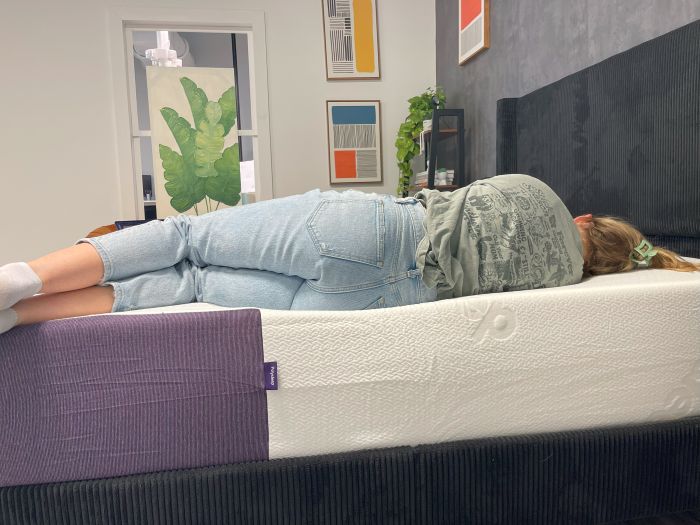
Our lightweight tester started out on her side. Immediately, she noted that she wasn’t aligned. “My shoulders felt more on top of the mattress than my lower half did, which I think would cause pain throughout the night,” she explained. She could feel pressure starting to build up in her shoulder blades the longer she lay there, so she rated side-sleeping pressure relief comfort at a 2.5/5.
On her back, there was a noticeable difference. “There was better pressure relief on my back, but it wasn’t equally supported,” she said. Her hips were still sinking in too far, putting her at risk for lower back pain. “It wasn’t the most uncomfortable, but I wouldn’t recommend it to a light weight sleeper,” she finished, giving back-sleeping pressure relief a minutely better score of 3/5.
Our average-weight tester was Sosha Lewis. She didn’t experience the alignment issues that our lightweight tester did, but she did have some issues around her shoulder. “The doughy upper layer doesn’t provide enough cushioning to keep my shoulder from driving into the mattress as I lay there longer,” she explained. She didn’t notice any pressure on her hips, but still rated the pressure relief in this position at a 3/5.
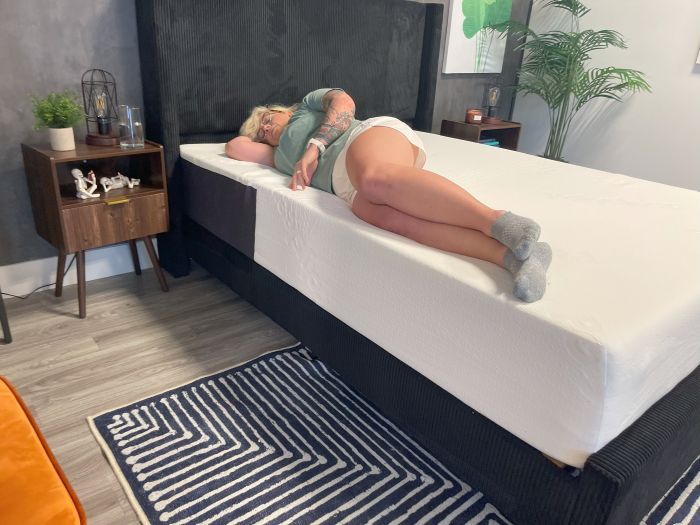
Back sleeping for Sosha was where the Polysleep Luna earned its best score of 4.5/5. She could feel both cushioning and support. “I liked how it felt around my lower back, as well as the overall balanced and even feeling,” Sosha said. She didn’t know if she’d sleep on this every night, so she docked half a point. But average-weight back sleepers are probably going to fare best for pressure relief.
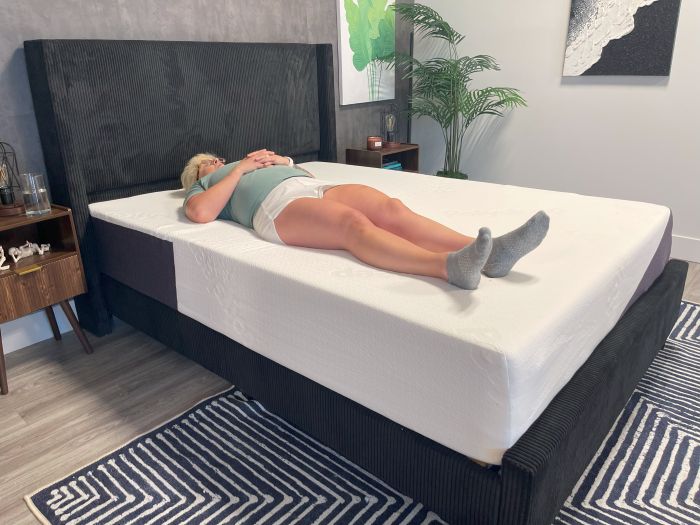
Sleepers over 230 pounds may also have mixed results. They’re likely to sink further into this mattress, but since it’s mostly made up of supportive foam, these sleepers might not get as much cushioning on their side. When it comes to folks with bigger builds, I’d only feel safe recommending this bed to back sleepers.
Edge Support
A bed with good edge support has a perimeter that won’t sag when bearing weight. “Edge support can be a sign of a durable mattress, but it also can help older adults and those with mobility concerns get in and out of bed more easily,” says Dr. Raj Dasgupta. This is why we test edge support in two areas: first, sitting on the edge and getting in and out of bed to see how it feels, and then lying at the edge in each sleeping position. We also place weights at the very edge of the mattress to get measurements of how much it sinks.
For the first test, our in-house expert tester wasn’t impressed. While the mattress is responsive, which can help folks “bounce” out of bed, it wasn’t enough to completely satisfy our concerns. “I feel like seniors may need some help due to how low the edge sinks,” our tester explained, rating edge support in this position at 3.5/5.
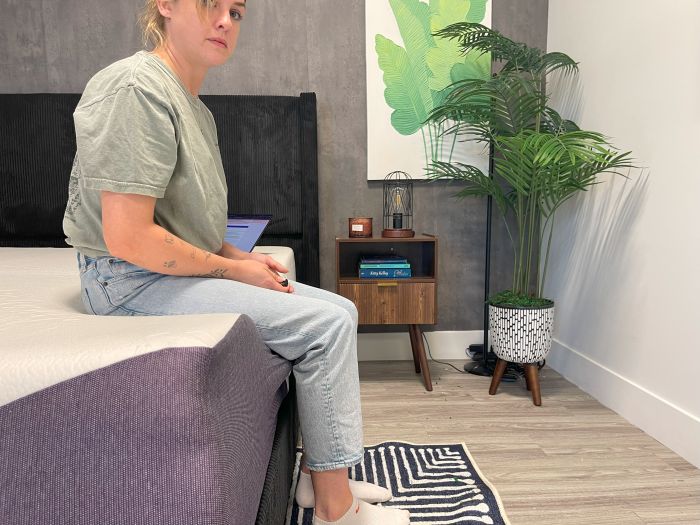
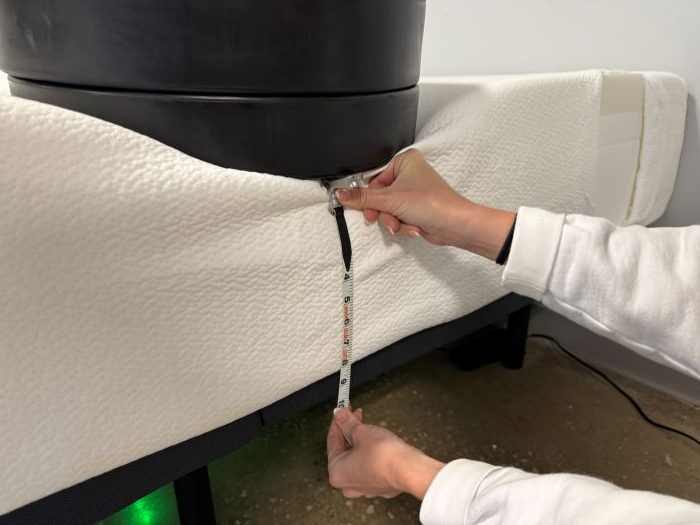
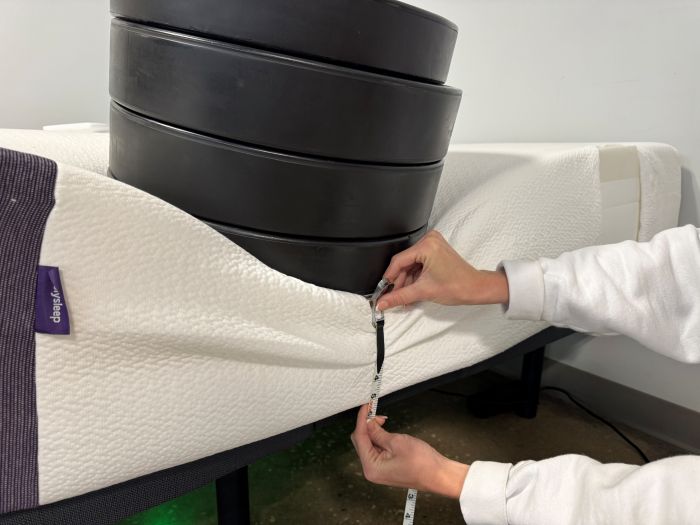
“Lying down felt better than when I was sitting,” she added. Again, it was easy to switch between positions because of the bed’s subtle bounce, but it wasn’t without its issues. Back and stomach sleeping felt more secure than side sleeping. “My hips and butt sunk into the mattress enough that I felt like my backside could fall off,” our tester explained. She did rate edge support in this test at a 4/5. The overall edge support thus came to 3.9/5, which is only about average.
Cooling
Getting a cool night’s sleep is important to many, including those who tend to overheat. Generally, we don’t recommend all-foam mattresses for these folks, as this material tends to trap heat rather than allow for airflow. Most manufacturers try to counteract this by using specialized foams infused with cooling gel or with more open-celled designs, as in the Polysleep Luna’s first comfort layer.
To test a bed’s cooling capability, we use a thermal gun to measure the surface temperature of the bed and record how much it increases after about seven minutes of snoozing on it. The most typical increase we see is around 6 to 7 degrees, which I would consider decent cooling.
The initial temperature reading for the Luna was 63.8 degrees, and after seven minutes, the thermal gun read 76.1. This whopping 12.3 increase is nearly twice what we would expect to see, and it’s the reason for the Polysleep Luna’s low cooling score (2.5/5).
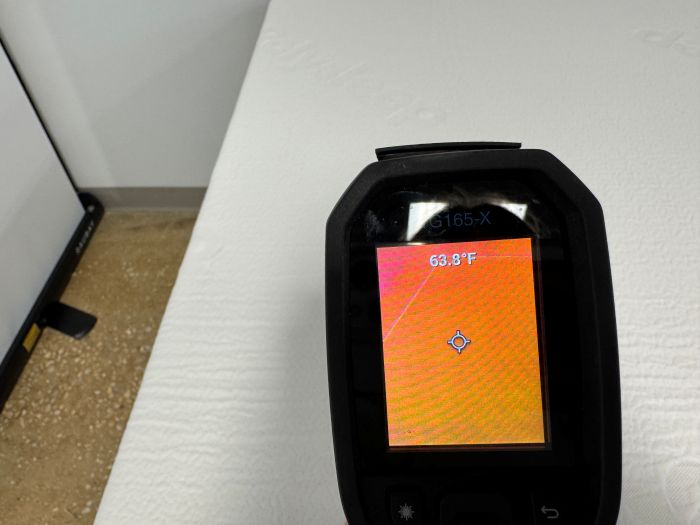
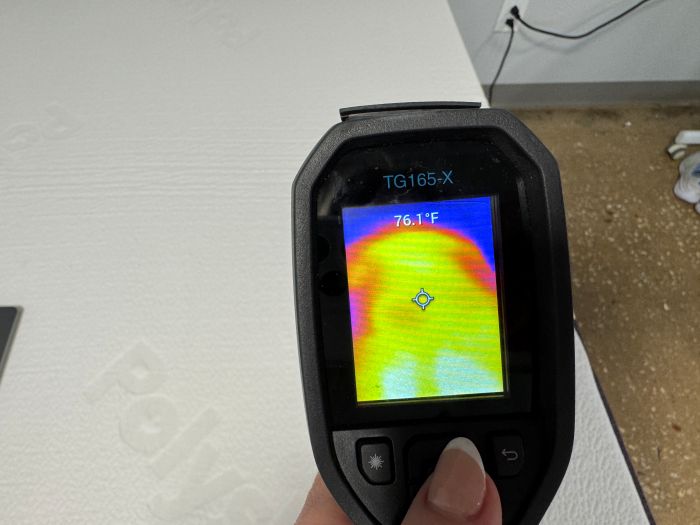
You’d think, then, that this mattress would feel like sleeping in a furnace. But the tester who recorded the cooling metrics was surprised by the results. “I didn’t feel the mattress heating up or retaining my body heat while lying on it,” she said. “The cover has a cool-to-touch feel and does a really good job of cooling down very quickly.”
Cooling, therefore, might be more subjective on this bed. That said, I don’t feel comfortable recommending the Luna to my fellow hot sleepers.
Motion Isolation
Does your partner’s tossing and turning carry across the bed and wake you up? Then you might need a bed with great motion isolation. This refers to how well a bed absorbs motion before it travels across the surface and disrupts whomever is trying to sleep peacefully on the other side.
We test motion isolation in two ways. First, we place a glass of water on one side of the bed. When we move around on the other, we observe how the glass behaves. The amount of rippling or wobbling we witness is a good indicator of how much movement is being felt on the bed. Sosha Lewis was our motion isolation tester, and she was impressed by how little disturbance she witnessed in the glass. “Even when I was rolling aggressively near the glass of water, it didn’t ripple much,” she said, rating this test at a 5/5.
The next test requires some help from another tester. One person will lie down blindfolded while the other moves around, mimicking typical movements from a rowdy co-sleeper. Sosha took the role of the annoying bedmate, moving around and getting in and out of bed. “My partner could not feel me get in and out of bed at all,” she said. “She could feel when I was moving about like a partner changing positions but said that it was more the cover moving and not the mattress.” For that, Sosha deducted half a point, but still praised the bed as an excellent option for couples. Ultimately the mattress earned an overall motion isolation score of 4.7/5.
Response
Response refers to how well a mattress bounces back when you press, sit, or lie on it. This category should be of interest to combination sleepers and sexually active shoppers, who may want to prioritize a bed that’s more responsive and easier to move around on.
To test response, we do just that: move around on top of the bed. We roll, wiggle, and switch between preferred positions to see if the bed springs back or holds onto us like slow-moving molasses. Sosha was again responsible for this test and thought it was overall fairly easy to move around on. “There is some initial sinkage when you get on the bed that provides the slightest bit of resistance,” she said. “However, you’re quickly met with a firmer, more supportive layer that allows you to move back and forth pretty easily.”
Sosha deducted half a point for this initial “doughiness” she encountered, but ultimately reasoned that with a 4.5/5 score, this bed should work great for folks seeking ease of movement on their mattress surface.
Sinkage: Light
Sinkage can be good or bad depending on your preferences. If you like to feel “hugged” by your mattress, you might want a bed with plenty of sinkage. If you hate the feeling of being stuck, you might want low sinkage. To capture sinkage, we placed a weight on the surface of this mattress and measured how much it dipped with a tape measure. The result was a meager 2.5 inches, lower than the average 3-inch depth from all the other beds we’ve tested. This lower sinkage means you’ll likely feel more “on top” of this bed rather than in it, so don’t expect to feel swaddled like a baby on the Luna.
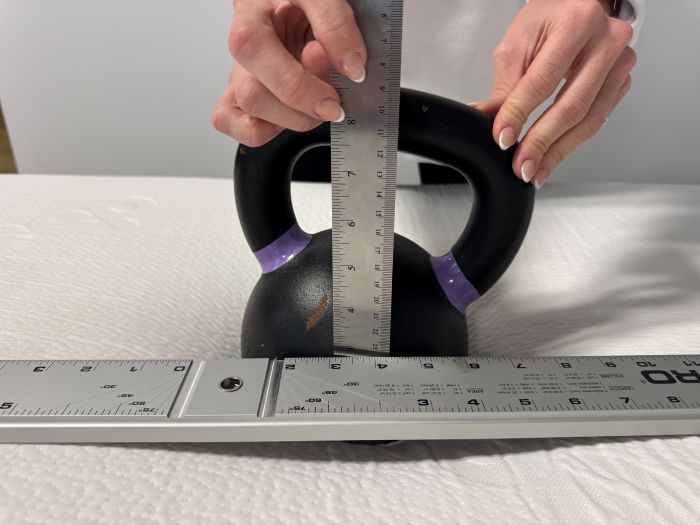
Bounce: High
Like response, bounce is a good way to determine how easy it will be to move around on the mattress. To measure how bouncy a mattress is, we drop a weighted medicine ball from six feet in the air onto its surface, and then see how high it rebounds. The recorded bounce height for the Polysleep Luna was 20 inches, a bit higher than our average of around 18 inches. For a foam mattress, this is pretty impressive. The Luna should have more of a springy feel than what you’d expect from slow-moving memory foam.
Noise
Throughout our testing, we move around on the mattress quite a bit. We pay extra attention to whether the mattress makes noise at any point. For the Polysleep Luna, it was quiet as a mouse. We didn’t expect many creaks from a memory foam mattress, but there also wasn’t any crinkling from the foams. We rated the noise at a perfect 5/5 score.
Sex
Whether a mattress is great for sex depends on three categories: response (for easy repositioning throughout the deed), edge support (to make full use of the playing field), and noise (so there are no distractions from the main event). To come up with a sex score for a mattress, we look at how the bed performed in these areas and tally the scores together.
The Polysleep Luna earned a 4.6/5 for sex, thanks to its perfect noise score and high response score (4.5/5). It did falter a bit in the edge support category, so keep that in mind for anything that might require more surface area. Otherwise, we think this bed is a great option for sexually active couples.
Adjustable Base Compatibility
Adjustable bases are a great way to level up your sleeping experience. They can help folks with back pain maintain a comfortable position while sleeping or watching TV, for one. They might also come with fancy features like massage or built-in lighting. Regardless, not every mattress that’s advertised as adjustable-base compatible actually performs well on a base. This is why we test mattresses in our studio on an adjustable base, so you can be sure they’ll work before spending the extra hundreds of dollars on a fancy frame.
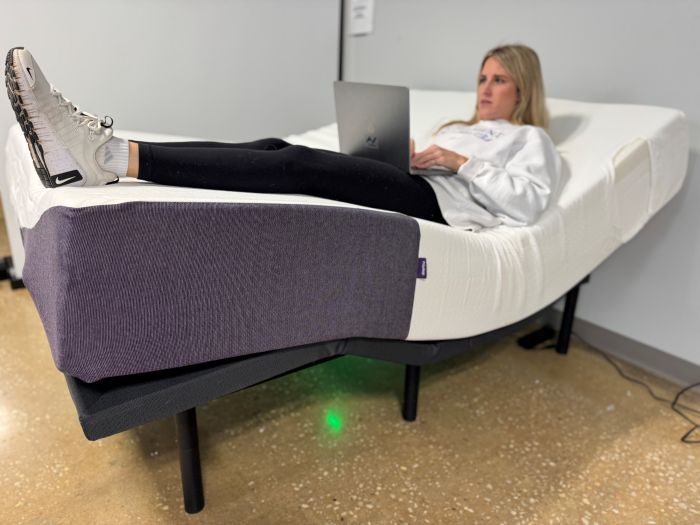
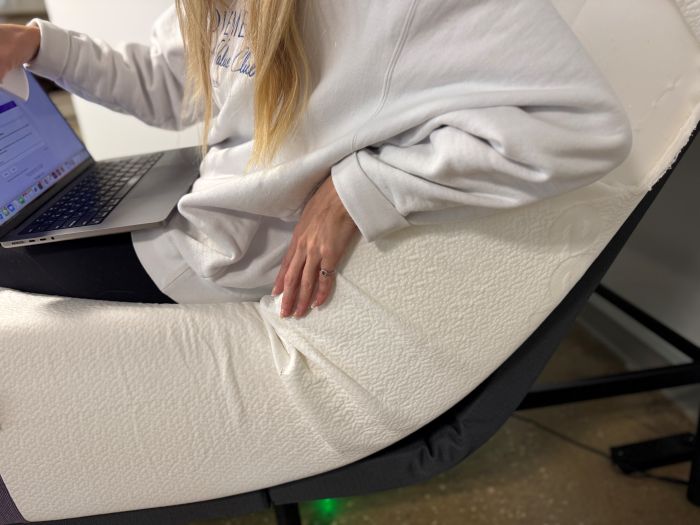
The Polysleep Luna performed “pretty well for the adjustable base test,” per our in-house tester. The only issue of note was that in the zero-gravity position (head and knees elevated), the bottom of the mattress lifted up a bit. Aside from this, the mattress’s foam base remained flush with the frame, even in the center where we see the most gapping.
Polysleep Luna Customer Experience Scores
Online mattress purchases come with more than just the mattress. Aside from any perks offered by the manufacturer, you may have to set up the mattress yourself if it comes in a box like the Polysleep Luna. I’ll go over everything you can expect from a customer service and experience standpoint with this bed.
Trial Period
If you can’t take a look at a bed in-store, your next best bet is a sleep trial. Most online mattress retailers offer these as a period to “try before you buy.” Polysleep mattresses come with a 100-night trial, a fairly common length. It gives you a few months to get a feel for your mattress, which is helpful but pales in comparison to the full year that some brands offer.
If you decide to return your Polysleep mattress, it’ll cost you a flat return fee. You’re also only guaranteed a partial refund. Certain remote territories can’t take advantage of the sleep trial due to logistic issues with returning or donating a mattress. With all this in mind, we rated the trial period at 3.5/5.
Warranty
A mattress can be a lifelong investment, so brands also offer warranties to back up their products. The most common type is a 10-year warranty, which is what Polysleep offers for the Luna mattress. A typical mattress usually lasts from 7 to 10 years, so you should be covered for this period. However, it’s not the most optimal out there, as I’ve seen 15-year, 20-year, and even lifetime warranties for mattresses. For this reason we gave the Polysleep Luna another 3.5/5 score for its warranty.
Unboxing
By the time we unboxed this mattress in our studio, the cardboard was in rough shape, so our testers didn’t have too much trouble getting it out. “The first layer of plastic was more of a pain to get off but the second layer is much easier,” one of our testers said. She gave the Luna a 3/5 for the overall experience, noting it was a bit of a hassle. However, she found that the mattress started to expand and spring to life pretty quickly, so you shouldn’t have any issues with waiting for it to fully rise.
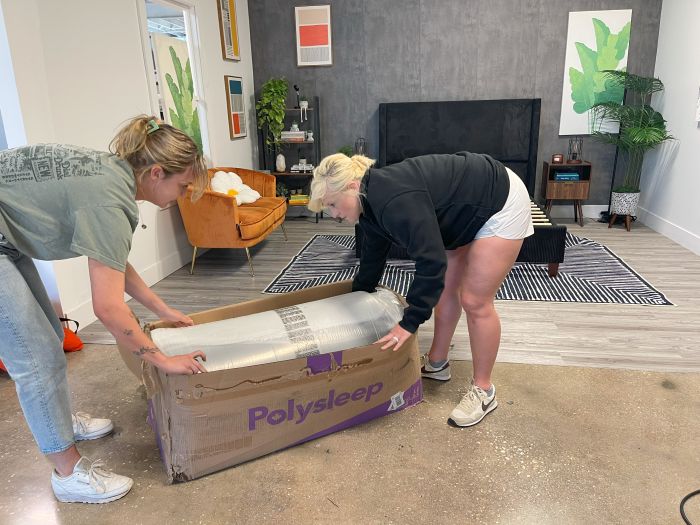
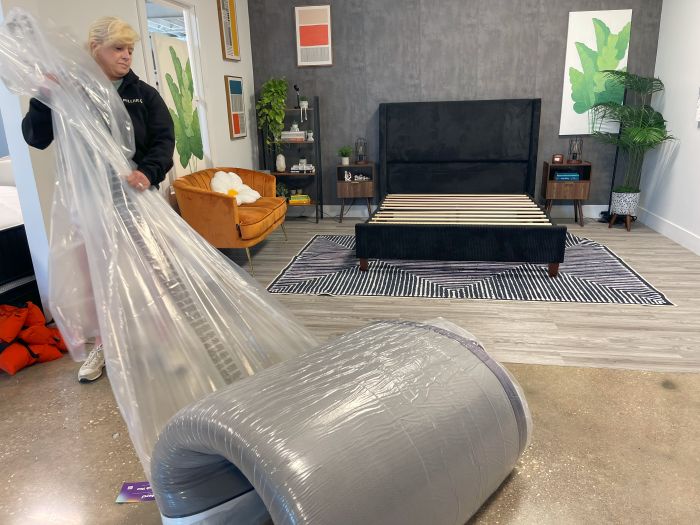
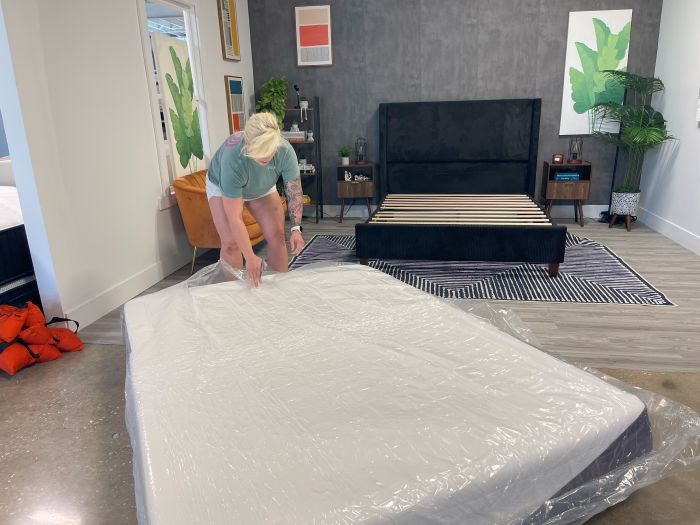
Off-gassing
Off-gassing refers to that “new mattress smell” that comes from a recently unboxed mattress. This is because they’re usually shipped straight from the factory and don’t have time to air out. It’s often harmless, but it can be a pain if you’ve got a sensitive nose.
Unfortunately, the tester who unboxed this mattress thought the Polysleep Luna was “one of the most strongly smelling mattresses I’ve opened.” It was noticeable immediately upon unboxing and wasn’t exactly pleasant. Moreover, our tester claimed, “It seems like it’ll take a while for this to go away.” She rated the off-gassing at 3/5.
Polysleep Luna Construction
Now that you understand what this mattress can do, let’s take a look at what’s inside it.
Mattress Height & Weight
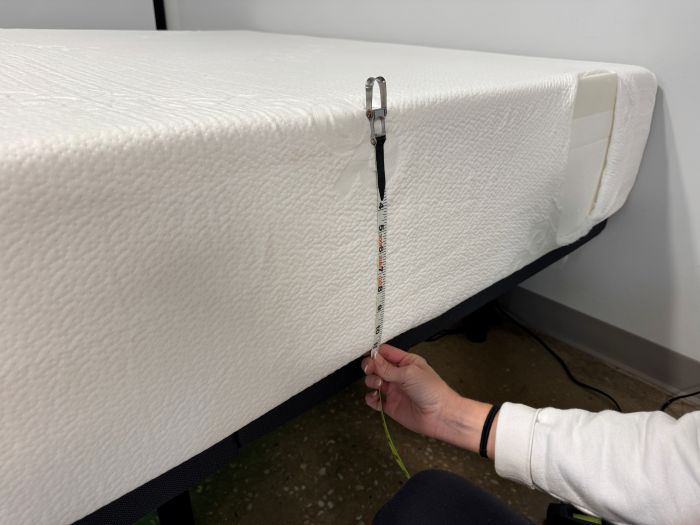
The Polysleep Luna mattress is 12 inches thick. It can weigh anywhere from 55 pounds to 108 pounds depending on which size you choose. A queen-size Luna mattress will weigh about 87 pounds.
Materials
The Polysleep Luna mattress is an all-foam mattress. It’s made up of multiple layers of specialized foams. Polysleep mattresses are all made in Canada with CertiPUR-US certified foams.
Layers
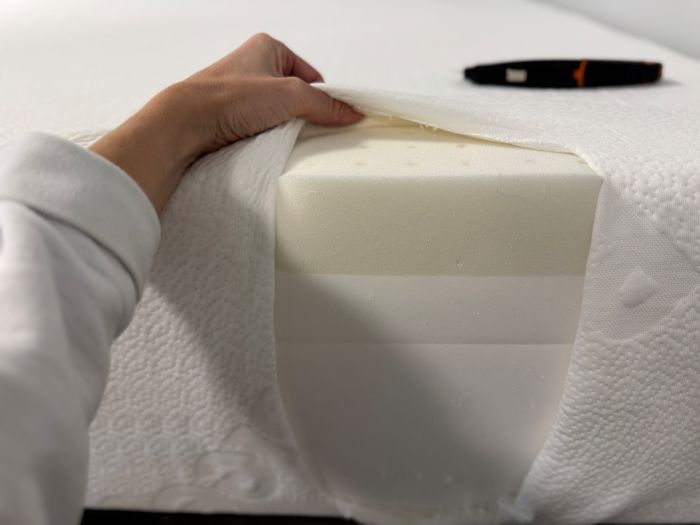
The cover of the Polysleep Luna mattress is made up of a blend of breathable fibers, providing a comfortably cool sleep surface.
The bulk of the mattress is composed of three distinct foam layers. The top layer is made up of viscoelastic, antimicrobial foam with an open-cell construction that keeps air flowing through it. Next is a high-density transitional layer of foam that eases into the base layer made of supportive foam, which acts as a stable foundation.
How to Try and Buy the Polysleep Luna Mattress
Polysleep mattresses are available online on the brand’s site or at select retailers throughout Canada and the United States. On the site’s map search function, you can even find hotels and AirBnb rentals that use the mattresses in their rooms.
If you’re not looking to book a night’s stay to get a feel for this mattress, you can take advantage of the brand’s sleep trial. From the moment the bed arrives compressed in a neat little box at your door, you have 100 nights to get a feel for it. If after 45 nights you decide it’s not for you, you can return it. Just note that it’ll cost you a flat return fee, and you’ll only receive a partial refund.
Polysleep Luna Prices & Sizes
| Size | Dimensions | Price |
| Twin | 38 x 75 | $1045.00 |
| Twin XL | 38 x 80 | $1095.00 |
| Full | 53 x 75 | $1275.00 |
| Queen | 60 x 80 | $1375.00 |
| King | 76 x 80 | $1595.00 |
| California King | 72 x 84 | $1595.00 |
How the Polysleep Luna Compares
Didn’t find what you were looking for? Check out some other mattresses that might suit your fancy.
- Nectar Mattress – More Affordable
- WinkBeds GravityLux Mattress – Cooler Foam
- Polysleep Sierra – Another Brand Option
| Rating |
|
|
|
|
|---|---|---|---|---|
| Firmness |
Medium-firm: 7/10
|
Medium-firm: 7/10
|
Multiple firmness options
|
Soft: 6/10
|
| Material |
Foam
|
Foam
|
Foam
|
Foam
|
| Cooling |
—
|
—
|
|
—
|
| Best For |
Side Sleepers,
Back Sleepers |
Side Sleepers,
Back Sleepers, Stomach Sleepers |
Back Sleepers,
Hot Sleepers |
Back Sleepers,
Stomach Sleepers |
|
|
Polysleep Luna vs. Nectar Classic Memory Foam
Nectar is a well-recognized name in the mattress game, famous for its flagship affordable memory foam mattress. If you’re balking at the Polysleep Luna’s price, you’ll be pleased by the Nectar’s sub-$700 price tag for a queen.
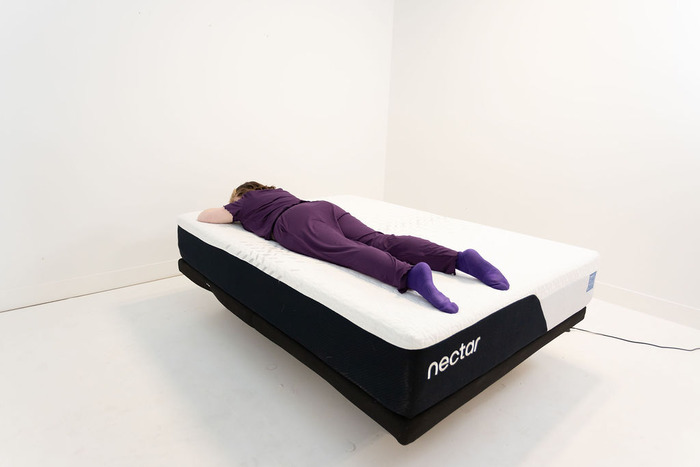
Both these mattresses came in at a 7/10 on our firmness scale, but their feels varied. I tested out the Nectar and noticed more of a traditional memory foam feel. You’ll sink more into that mattress than the Polysleep Luna. Both beds are great for back sleepers, but I also enjoyed the Nectar on my stomach, as it provided the right mix of support and contouring.
The Nectar mattress is also outfitted with a cooling cover, which I found helped to keep it much cooler than typical memory foam mattresses. However, the Luna seems to have more bounce, so it’s the better choice for combination sleepers or sexually active couples.
Polysleep Luna vs. WinkBeds GravityLux
The GravityLux by WinkBeds is the brand’s sole all-foam mattress. Like the Polysleep Luna, it’s got a firmer feel, but it came in even firmer on our scale at 7.5/10. If you’re looking for lift, it’s the bed for you. It should work great for stomach and back sleepers. But if you’re looking for something a touch softer, I’d stick to the Polysleep Luna.
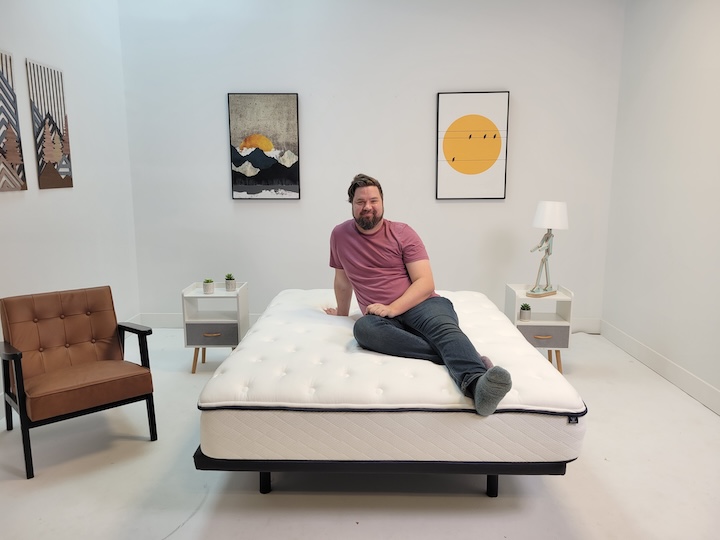
The main difference between these two beds is their cooling abilities. Where the Luna received mixed results, the GravityLux performed well in our temperature regulation test, a rarity for an all-foam mattress. If you’re a hot sleeper, choose the GravityLux.
It might all come down to price. A Polysleep Luna mattress will cost $1,375 for a queen without sales or coupons. The GravityLux comes in at just a smidge more at $1,499.
Polysleep Luna vs. Polysleep Sierra
Another Polysleep mattress that might interest shoppers is the Sierra model. This is another all-foam mattress, though Polysleep touts it as its most affordable option. A queen-size mattress will run you just $690, which is half of what the same size Luna mattress will cost. If you’re focused on budget, the Sierra might be your best bet.
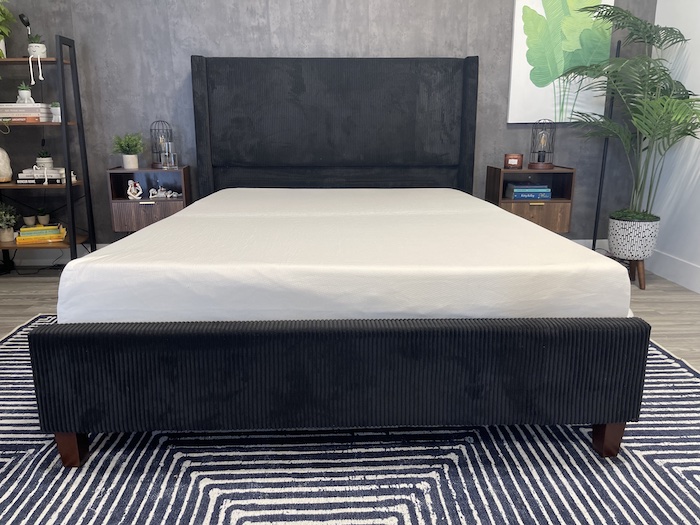
In terms of feel, these mattresses have a similar profile, but our testers found the Sierra just a touch softer, coming in at 6/10 on our firmness scale compared to Luna’s 7/10 score. If you’re a side sleeper, you’ll likely have better luck on the Sierra. Back sleepers might prefer the firmer feel of the Luna. Otherwise, the beds both scored similarly in our tests, so they’re fairly comparable.
Polysleep Luna Mattress FAQs
Is the Polysleep Luna mattress any good?
The Polysleep Luna is a good mattress for back sleepers looking for sturdy, supportive foams. It earned its highest scores in response and motion isolation, so it should also work well for combination sleepers and couples.
Do Polysleep mattresses use fiberglass?
Polysleep mattresses do not use fiberglass in their construction.
